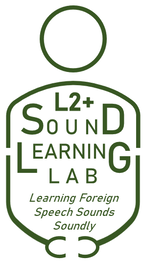Research Overview
My main linguistic research interests to date include second language (L2) acquisition of phonology and lexicon, historical Germanic linguistics, phonology and morphology of Modern German, and phonological analysis of some Chinese tone sandhi shifts. I am familiar with a variety of linguistics, applied linguistics, and language acquisition frameworks, including laboratory psycholinguistic, feature geometry, and Optimality Theory approaches to phonology, as well as socio-cultural and pedagogical approaches to L2 acquisition.
Originally an offshoot of linguistics, second language acquisition (SLA) is still a young field. In particular, L2 phonology is still in its infancy. As experimental methods are adopted from cognitive science, psychology, and speech and hearing sciences, quantitative SLA research is rapidly growing due to its new ability to test hypotheses with instruments sensitive enough to detect subtle effects. With my own research, I aim to examine phonological development in L2 acquisition and explore how phonological information is cognitively represented.
L2+ Sound Learning Lab
|
My primary research area is in second language (L2) acquisition, which includes countless more complex scenarios of additional language learning after L2 exposure, conventionally referred to as third-language (L3) acquisition. As principal investigator of the L2+ Sound Learning Lab, I investigate adult language learning in foreign language settings (as opposed to immersion), which characterizes most university-level language learning in North America.
Learning to speak a foreign language entails (a) reliable perception of the target language's individual sounds, words, and contours; (b) learner production of the target language that is sufficiently comprehensible to empower learners to communicate with other speakers of the target language; and (c) development of both linguistic and cultural competencies to link listening, speaking, and meaning. Our lab's current research, funded by the University of Calgary Faculty of Arts and the Social Sciences and Humanities Research Council, investigates the impacts of aural training on early-stage adult L2 learners of German, including the potential to enhance perception of speech sounds and how they are linked to the novel orthography (spelling) of the target language in support of vocabulary learning and reducing the difficulty of listening comprehension in running speech. Ultimately, this research finds motivation from the fundamental idea that teaching and training adult learners toward these abilities early in their exposure is likely to have a profound impact on learner confidence and motivation to learn a foreign language long enough to achieve higher proficiency. |
Dissertation Research
I earned my Ph.D. from the Department of Second Language Studies at Indiana University in May 2019. My dissertation is available via ProQuest for free (open access).
My dissertation research explored the acquisition of higher-order phonology in L2 (e.g., phonotactics, allophones). Although it is clear that native speakers of any language typically acquire these patterns unconsciously, it is still unclear how or to what extent adult learners of foreign languages do so. These questions are relevant to linguistic theories of acquisition and may also inform what foreign language educators can or should (not) expect from their students when designing fair assessments of listening comprehension and pronunciation at various stages of development.
Many languages restrict the distribution of certain phonemes. In English, h [h] is only allowed at the beginning of stressed syllables as in hat and ng [ŋ] is only allowed at the end of syllables as in ring. Other languages may not restrict the same sounds in the same way. For example in Turkish, şah "shah" or "chess king", the final h is pronounced and is not unusual in the language. Similarly in Tagalog, the ng sound [ŋ] commonly appears at the beginning of words, as in nga "really, actually, indeed." Overcoming restrictions that apply in the student's native language in order to notice sounds in "new" places and then effectively learn and pronounce them may challenge many students.
In other cases, different versions of certain speech sounds may appear in different places within a language. This is much like how Clark Kent and Superman are the same man, but Superman never shows up at the Daily Planet and Clark Kent never flies over Metropolis. Similarly in American English, different versions of the t sound appear in tub as opposed to butter and the p sound occurs differently in American English pin vs. spin (and sometimes vs. snip as well.)
In order to explore the L2 acquisition of such alternations in my dissertation, I employed psycholinguistic laboratory methods (e.g., perceptual assimilation, phoneme detection). Using accuracy of detection and reaction time effects as a rubric for measuring acquisition of phonological rules, the study examines adult learners' perception of the so-called "deutsches ch," which appears as the ach-Laut [x]/[χ] in the word Buch "book" but as the ich-Laut [ç] in the word Bücher "books." The study compares adult learners in their 1st and 2nd year of university-level coursework in German over the course of 2 semesters with naïve American English speakers (who do not know German) and native Germans to paint a picture of the learners' path(s) of development with regard to these sounds in L2 German.
My dissertation research explored the acquisition of higher-order phonology in L2 (e.g., phonotactics, allophones). Although it is clear that native speakers of any language typically acquire these patterns unconsciously, it is still unclear how or to what extent adult learners of foreign languages do so. These questions are relevant to linguistic theories of acquisition and may also inform what foreign language educators can or should (not) expect from their students when designing fair assessments of listening comprehension and pronunciation at various stages of development.
Many languages restrict the distribution of certain phonemes. In English, h [h] is only allowed at the beginning of stressed syllables as in hat and ng [ŋ] is only allowed at the end of syllables as in ring. Other languages may not restrict the same sounds in the same way. For example in Turkish, şah "shah" or "chess king", the final h is pronounced and is not unusual in the language. Similarly in Tagalog, the ng sound [ŋ] commonly appears at the beginning of words, as in nga "really, actually, indeed." Overcoming restrictions that apply in the student's native language in order to notice sounds in "new" places and then effectively learn and pronounce them may challenge many students.
In other cases, different versions of certain speech sounds may appear in different places within a language. This is much like how Clark Kent and Superman are the same man, but Superman never shows up at the Daily Planet and Clark Kent never flies over Metropolis. Similarly in American English, different versions of the t sound appear in tub as opposed to butter and the p sound occurs differently in American English pin vs. spin (and sometimes vs. snip as well.)
In order to explore the L2 acquisition of such alternations in my dissertation, I employed psycholinguistic laboratory methods (e.g., perceptual assimilation, phoneme detection). Using accuracy of detection and reaction time effects as a rubric for measuring acquisition of phonological rules, the study examines adult learners' perception of the so-called "deutsches ch," which appears as the ach-Laut [x]/[χ] in the word Buch "book" but as the ich-Laut [ç] in the word Bücher "books." The study compares adult learners in their 1st and 2nd year of university-level coursework in German over the course of 2 semesters with naïve American English speakers (who do not know German) and native Germans to paint a picture of the learners' path(s) of development with regard to these sounds in L2 German.
Research Articles
Refereed Articles
Scott, J. H. G., & Darcy, I. (2023). Prosodic location modulates listeners’ perception of novel German sounds. Laboratory Phonology, 14(1). doi: 10.16995/labphon.6428 Scott, J. H. G., Lim, R. Z. J., & Russell, C. B. (2022). Sound-spelling correspondences in FL instruction: same script, different rules. In J. Levis & A. Guskaroska (Eds.), Proceedings of the 12th Pronunciation in Second Language Learning and Teaching Conference, St. Catharines, ON [virtual], June 2021. St. Catharines, ON: Brock University. doi:10.31274/psllt.13361 Scott, J. H. G. (2019). Who follows the rules? Differential robustness of phonological principles. In J. Levis, C. Nagle, & E. Todey (Eds.), Proceedings of the 10th Pronunciation in Second Language Learning and Teaching Conference, ISSN 2380-9566, Ames, IA, September 2018 (pp. 213–225). Ames, IA: Iowa State University. [link] Darcy, I., Dekydtspotter , L., Sprouse, R. A., Glover, J., Kaden, C., McGuire, M., & Scott, J. H. G. (2012). Direct mapping of acoustics to phonology: On the lexical encoding of front rounded vowels in L1 English–L2 French acquisition. Second Language Research, 28, 5–40. doi: 10.1177/0267658311423455 Hall, T. A., & Scott, J. H. G. (2007). Inflectional paradigms have a base: Evidence from s-dissimilation in Southern German dialects. Morphology, 17, 151–178. doi: 10.1007/s11525-007-9112-z Other Publications Scott, J. H. G. (2001). German Particle-Complement Verbs in Modern Morphological and Syntactic Theory: Countering the ‘Separable-Prefix’ Misnomer. University of Washington Working Papers in Linguistics, 20, 99–117. |
Book Reviews
Scott, J. H. G. (2014). Review of the book The Cambridge handbook of second language acquisition, by J. Herschensohn & M. Young-Scholten (Eds.). Studies in Second Language Acquisition, 36, 169–171. doi: 10.1017/S0272263113000673
|
Academic Presentations
Invited Talks
Scott, J. H. G. (2023, July 8). Künstliche Sprachen und sprachliche Kunst: (Un)natürliche Grenzen zu Bruch [Artificial languages and linguistic art: (Un)natural boundaries broken down [Invited presentation]. Deutsche Sommerschule am Pazifik, Portland State University, Portland, OR. Scott, J. H. G. (2023, February 20). Constructed languages: Historical functions, aesthetic value, and cultural applications [Invited presentation]. Department of World Languages and Cultures, Portland State University, Portland OR. [slides] Scott, J. H. G., & Süßenbach, L. (2021, June 23). Perception, pronunciation, orthography and High-Variability Phonetic Training in foreign language [Webinar]. TESOL International Association: Speech, Pronunciation, and Listening Interest Section (SPLIS). [video link] Scott, J. H. G. (2015, June). Allophonic alternations and phonotactic constraints governing [ç], [x], and [h] for L2 learners of German. Paper presented at Lingulab Mini-Workshop (June 26), Tübingen, Germany. Scott, J. H. G. (2015, June). Allophonic and phonotactic distributions in L2 German: [ç] and [x] as a case of e pluribus unum for L1 American English speakers. Paper presented at Sonderforschungsbereich (SFB) 732 Project A4 Colloquium (June 25), Stuttgart, Germany. Scott, J. H. G. (2015, June). L2 acquisition of alternation and phonotactic constraints governing distribution of German [ç], [x], and [h] by L1 American English speakers. Paper presented at Sonderforschungsbereich (SFB) 732 Annual Retreat (June 19), Kleinwalsertal, Austria. Scott, J. H. G. (2015, May). Acquisition of alternation and phonotactic distribution constraints governing L2 German [ç] and [x] by L1 American English speakers. Paper presented at Sonderforschungsbereich (SFB) 732 Project A7 Colloquium (May 18), Stuttgart, Germany. Papers/Posters Presented Scott, J. H. G., Phillips, S. E., Lim, R. Z. J., Russell, C. B., Darcy, I., & Süßenbach, L. (2023, September 8). Phonetic training for novel category perception and orthographic learning: Relative gains of low- and high-variability for beginners of German [Paper presentation]. 14th Annual Pronunciation in Second Language Learning and Teaching (PSLLT) Conference, West Lafayette, IN. https://web.cvent.com/event/e0861a1b-556f-4a6c-8e1a-3f11196b6380/summary Scott, J. H. G., Phillips, S. E., Russel, C. B., Lim, R. Z. J., Darcy, I., & Süßenbach, L. (2023, 22 April). Effects of Low- and High-Variability Phonetic Training on Category Perception and Orthographic Awareness in Early L2 German [Paper presentation]. Germanic Linguistics Annual Conference 2023, Banff, AB, Canada. https://glac2023.ca/ Scott, J. H. G., Lim, R. Z. J., & Russell, C. B. (2021, June 18). Sound-spelling correspondences in FL instruction: Same script, different rules [Paper presentation]. 12th Annual Pronunciation and Second Language Learning and Teaching (PSLLT) Conference, St. Catharines, ON. https://brocku.ca/psllt-2021/ Scott, J. H. G., Russell, C. B., & Lim, R. Z. J. (2021, May 12). Sound and spelling in L2/L3 German: Same script, different rules [Paper presentation]. Twenty-Seventh Germanic Linguistics Annual Conference (GLAC-27), Madison, WI. https://glac2021.weebly.com/ Scott, J. H. G., & Darcy, I. (2020, July). German unassimilated coronal nasals cause reduced inhibition. Poster session presented at LabPhon17, Vancouver, BC, Canada. https://labphon.org/labphon17/detailed-programme Scott, J. H. G., & Darcy, I. (2020, April). Psycholinguistic evidence for underspecification: German Regressive Nasal Assimilation [Conference session]. Twenty-Sixth Germanic Linguistics Annual Conference (GLAC-26), Athens, GA. https://glac2020.weebly.com/ (Conference canceled) Scott, J. H. G., & Darcy, I. (2019, May). The Awfully Elusive German Language: In Search of a Property Theory of Mid and Back Continuants. Poster presented at the Twenty-Fifth Germanic Linguistics Annual Conference (GLAC-25), Iowa City, IA. [Abstract] [PDF Version] Scott, J. H. G. (2018, September). Who Follows the Rules? Differential Robustness of Phonological Principles. Paper presented at the 10th Annual Pronunciation and Second Language Learning and Teaching (PSLLT) Conference, Ames, IA. [PDF Version] Scott, J. H. G., & Darcy, I. (2018, May). Phonetic Category Revision in Early L2 German Dorsal Fricatives: From Naïve Listener to Beginning Learner. Paper presented at the Twenty-Fourth Germanic Linguistics Annual Conference (GLAC-24), State College, PA. [Abstract] [PDF Version] Scott, J. H. G. (2017, May). Jigsaw Surveys & Learning Logs: Using Qualtrics and Canvas for Student-Centered Learning. Paper presented at Faculty Con 2017 (May 10), Indianapolis, IN. [PDF Version] Scott, J.H.G., & Darcy, I. (2016, June). There Goes the Neighborhood! Avoiding Labels in L2 Phoneme Detection. Paper presented at New Sounds 2016: 8th International Conference on Second-Language Speech, Aarhus, Denmark. [PDF Version] Scott, J. H. G. (2016, April). Where It Is and How It’s Writ: Influences on Cross-Language Perceptual Assimilation of German Fricatives. Paper presented at Sound to Word in Bilingual and Second Language Speech Perception (Sound to Word 2016), Iowa City, IA. Scott, J. H. G. (2015, May). Position-sensitive perceptual assimilation of German dorsal fricatives by L1 English pre-learners: The initial state for acquisition of an L2 phonological alternation. Paper presented at the Twenty-First Germanic Linguistics Annual Conference (GLAC-21), Provo, UT. Sprouse, R. A., Seo, H.-K., El-Ghazoly, B., Gabriele, L. McGuire, M. Mossman, S., Scott, J. H. G., & Su, Y. (2013, October-November). Deep lexical transfer and the acquisition of the English dative alternation. Poster presented at the 32nd Second Language Research Forum (SLRF), Provo, UT. Scott, J. H.G. (2013, April). West-Germanic Gemination: Stress, Sonority and the Split Margin Approach. Paper presented at the Nineteenth Germanic Linguistics Annual Conference (GLAC-19), Buffalo, NY. Darcy, I., Dekydtspotter, L., Sprouse, R. A., Daidone, D., Kaden, C., Krueger, F., & Scott, J. H. G. (2012, April). Asymmetric development in lexical encoding of L1-English L2-German front rounded vowels. Paper presented at the Eighteenth Germanic Linguistics Annual Conference (GLAC-18), Bloomington, IN. Scott, J. H. G. (2011, April). Labio-Laryngeal Fricative of Voiceless Labio-Velar Approximant?: Ƕaþ with the Gothic <ƕ>? Paper presented at the Seventeenth Germanic Linguistics Annual Conference (GLAC-17), Austin, TX. Scott, J. H. G. (2011, February). Doorknobs, Beans, Sex and Doorknobs. Paper presented at the Eighth Biennial Graduate Student Conference, Bloomington, IN. Scott, J. H. G. (2010, April-May). On the Gemination of /w/ in West Germanic One Hundred Twenty-Four Years Later. Paper presented at the Sixteenth Germanic Linguistics Annual Conference (GLAC-16), Milwaukee, WI. Darcy, I., Dekydtspotter, L., Sprouse, R. A., Glover, J., Kaden, C., McGuire, M., Schaefer, V. & Scott, J. H. G. (2009, November). The contours of lexico-phonological dissociation in English-French interlanguage. Poster presented to the 34th Boston University Conference on Language Development, Boston, MA. Darcy, I., Dekydtspotter, L., Sprouse, R. A., Glover, J., Kaden, C., McGuire, M., Schaefer, V. & Scott, J. H. G. (2009, October). Lexical encoding of new phonological categories: An English-French interlanguage lexico-phonological study. Paper presented to the Second Language Research Forum, East Lansing, MI. Scott, J. H. G. (2009, October). A Positional Markedness Approach to Sandhi Tone Shift in Chaoyang Chinese. Paper presented at the 15th Mid-Continental Workshop on Phonology (McWOP 15), Bloomington, IN. Darcy, I., Dekydtspotter, L., Sprouse, R. A., Glover, J., Kaden, C., McGuire, M., Schaefer, V. & Scott, J. H. G. (2009, May). Category formation and lexical encoding of a new contrast. Poster presented to The Acoustical Society of America's 2nd Special Workshop on Speech: Cross-language speech perception and variation in linguistic experience. Portland, OR. Scott, J. H. G. (2008, May). The Monostratal Approach over the Cycle and Directional Asymmetry in Morphophonology. Paper presented at the Fourteenth Germanic Linguistics Annual Conference (GLAC-14), Madison, WI. Scott, J. H. G. (2007, October). On the Nature of Gothic /s/ and /sC/ Clusters with Respect to Sanskrit. Paper presented at Philologists in Germanic Studies at Illinois and Indiana 13 (PIGSTII 13), Urbana-Champaign, IL. Scott, J. H. G. (2007, April). Onset Formation in Sanskrit and Gothic Partial Reduplications. Paper presented at the Thirteenth Germanic Linguistics Annual Conference (GLAC-13), State College, PA. Scott, J. H. G. (2006, April). Tautomorphemic Coronal Fricative Dissimilation in Swabian German /sC/ Clusters. Paper presented at the Twelfth Germanic Linguistics Annual Conference (GLAC-12), Urbana-Champaign, IL. Scott, J. H. G. (2006, April). Formalizing Rhotacization (/z/ > /r/) in NW Gmc: Norse Runic Evidence. Paper presented at the Berkeley Germanic Linguistics Roundtable, Berkeley, CA. |






